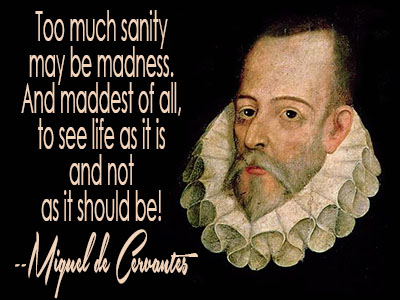Once we get to know the man and his life before becoming Don Quijote, he is immediately transformed into the famous knight through his obsession with reading. He literally goes mad trying to make sense of bad writing and wanting to believe in extreme fantasy. I have already mentioned that Cervantes criticizes the chivalric romances for their poor writing, predictable plots, and unrealistic characters and twists. His fervent and vocal dislike of this popular literature, a not-so-hard-to-miss dislike of the gentry, and a long imprisonment with a mad knight came together to form this rather wonderful story.
Here is an example of what drives Don Quijote crazy, "the reason for the unreason to which my reason turns so weakens my reason that with reason I complain of thy beauty" (Grossman 20).
 |
|
Can you understand it? If you read it enough times, then you can get an idea of what this writer is trying to say, but it never loses the frustrating feeling of verbose and unnecessarily confusing language. It is like the writer does everything to keep the reader from understanding, and Don Quijote stays awake all night puzzling over each sentence like this one. Cervantes claims that it is this language that causes our hero to go mad and decide to become a knight. Now, what is most fascinating to me, is the long descriptions of hundreds of tales of chivalry that show Cervantes himself must have read more than Don Quijote whose library is stacked full of the stories. Despite this satirical condemnation of the writing and fantasy of these stories, Cervantes enjoyed this type of tale. Perhaps, he too wanted to be a knight. It is not long after this that Velazquez is the first painter to become a knight, and while Shakespeare was not knighted, he was buried with kings.
So after reading without sleep and thinking about knights non-stop, Don Quijote goes mad and rushes to find his great-grandfather's rusted armor and replaces the missing helmet with a bucket of sorts.In his madness, he sees only a shining suit of armor and glorious helmet. Then, he renames his horse and himself after the style of the great knights and stallions in his stories. He becomes
Don Quijote ("a piece of armor covering the thigh") of La Mancha and his horse is now
Rocinante ("was a nag before"). Then, he must find his lady love, so he remembers a peasant girl who he was attracted to and decides to declare her
Dulcinea de Toboso ("the sweet of Toboso"). Once the renaming is done to match the names in his stories, he sallies forth to find someone to knight him and a battle to win to honor his lady love. It does not matter that the names do little to change a peasant girl into a princess, a nag into a thoroughbred, or a farmer into a knight.
 |
| The cuisse of the armor (French for thigh, Cuixa in Catalan) |
 |
| Rocinante showed up in Dora the Explorer! I happened to see this flipping through channels! |
 |
| More on Aldonza/Dulcinea when we get to Toboso! |
Don Quixote leaves in search of adventure until night falls and he is hungry and tired. He eventually finds a venta, which is like a small inn or tavern where travelers in La Mancha would stay for a night while traveling. There was not much in terms of large cities or hotels, but the roads stayed busy with travel between Madrid and Andalucia. Madrid was the capital, and Adalucia had the ports like Sevilla and Cadiz where boats left to the colonies or returned from them, fields of olive trees, vineyards for sherry, horses, and other luxury items that made it a wealthy region. This resulted in extensive trade routes passing through La Mancha between the center and the south of Spain.

Ventas were then small houses opened to travelers that provided meals and beds, similar to colonial guest houses or taverns that you can visit all over the East Coast. In one of these ventas, Don Quijote is knighted by the innkeeper (who he thinks is a lord) and waited on by prostitutes (who he thinks are princesses). His stay is cut short when he attacks the other guests for touching his armor. He leaves elated that he has been knighted and ready to be tested in battle. There is a venta in Puerto Lapice in La Mancha that is named Venta del Quijote where many tourists stay today. The town is mentioned by name in the novel, but there is no evidence that this is the venta where he was knighted.
  |
| The Venta |
We did not stop here since there was not much to see in Puerto Lapice other than this hotel, and there are plenty of places to eat and sleep. The reviews on Trip Adviser did not seem promising, and my husband had no real desire to go there, which seemed like good enough signs to spend time elsewhere. We are also used to American distances, especially driving in Texas, so an hour and a half is too close to Madrid to stop for the night. It may be a good rest stop or lunch break if you want to see it. If you do get a chance to go, I'd love to hear if I am right or wrong.
 |
| Consuegra is before you get to Puerto Lapice |
We skipped Puerto Lapice and this first sally of Don Quijote and went straight to Consuegra and the very famous windmills of La Mancha. I will begin with the second sally and the windmills in the next post.







No comments:
Post a Comment